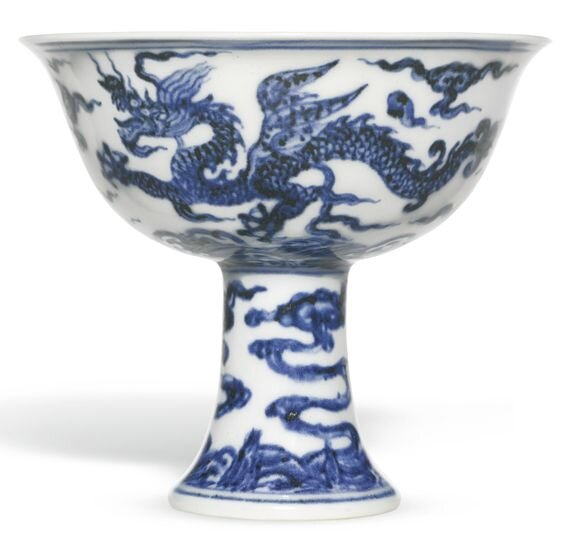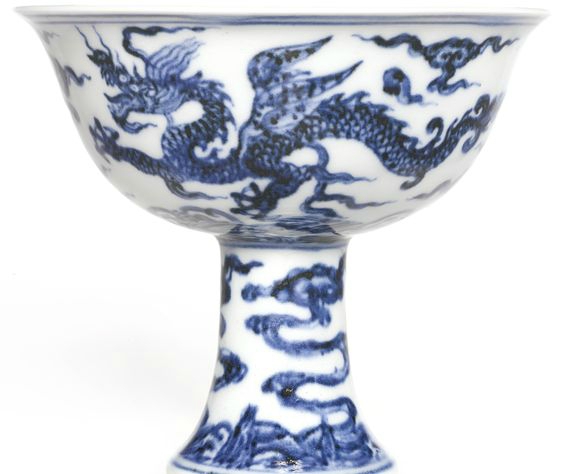A rare and important blue and white ‘winged dragon’ stemcup, Mark and period of Xuande
Lot 24. A rare and important blue and white ‘winged dragon’ stemcup, Mark and period of Xuande. Estimate 4,000,000 — 6,000,000 HKD (467,772 - 701,658 EUR). Sold 22,880,000 HKD (2,949,690 USD. Photo: Sotheby's.
finely potted with deep rounded sides rising to a gently flaring rim, supported on a tall splayed stem with a sealed flat base, superbly painted around the exterior in deep shades of underglaze blue accented with 'heaping and piling', the cup with two ferocious dragons striding amongst scrolling clouds above turbulent waves, each with a pair of wings springing from carefully detailed scaly bodies, their muscular legs terminating to sharp claws, their mouths opened revealing sharp fangs, all between double-line borders encircling the rim and waist of the cup, the stem decorated with vaporous scrolling clouds above evenly spaced, pointed jagged rocks, the interior of the cup left white and inscribed with a six-character reign mark within double circles repeated at the rim, the base unglazed, revealing the smooth white biscuit - 9 cm, 3 1/2 in.
Provenance: Presented by the Dalai Lama to the Viceroy of India, prior to 1926 (by repute).
Entered the Indian Toshkhaneh, or State Treasure House, prior to 1926 (by repute).
Collection of Sir John Thompson, K.C.S.I., K.C.I.E. (1873-1934), from 1926.
Collection of Sir Edward Wakefield, 1st Bt. (1903-1969), and Lalage, Lady Wakefield (1906-2001), from 1934 to 1967.
Sotheby's London, 14th November 1967, lot 96 (£950).
Bluett & Sons Ltd, London, 1967 (£950).
Collection of Roger Pilkington (1928-69), from 1967 (£950).
Note: Stemcups were used in Tibetan Buddhist rituals and the present piece, reputedly once in the possession of a former Dalai Lama before entering the Indian State Treasure House, may well have entered the collection of a Tibetan monastery in the early Ming dynasty, since both the Yongle (r. 1403-24) and the Xuande Emperors (r. 1426-35) were devout Buddhists and are known to have bestowed porcelains from the imperial kilns and other valuable ritual vessels onto Tibetan Buddhist institutions.
It is extremely rare to find these two-legged winged dragons on Xuande imperial porcelains of any form. Only one other stemcup of this design appears to be recorded, sold in our London rooms, 10th June 1986, lot 219, and probably the same cup again at Christie’s New York, 29th November 1990, lot 176; one other stemcup with winged dragons, but the stem decorated with waves and intersected by a raised knop, was offered in these rooms, 20th May 1986, lot 17; and one small jar of Xuande mark and period, with winged dragons rendered in a very different manner, was sold three times at auction, at Christie’s London, 14th December 1983, lot 407; and twice in these rooms, 10th April 2006, lot 1663, and 11th April 2008, lot 2931.
A related stemcup painted with a winged elephant and a winged lion, and waves at the stem, from the collection of Sir Percival David is illustrated in Sir Harry Garner, Oriental Blue and White, London, 1954, pl. 27 B.
Various other dragon stem cups of similar form, also of Xuande mark and period, are painted either with the more common four-legged, four-clawed dragons without wings and with stylised cloud scrolls on the stem, or with five-clawed dragons, with clouds or waves on the stem. According to the inventory of the porcelain collection in the National Palace Museum, Gugong ciqi lu [Record of porcelains from the Old Palace], Taichung, 1961-6, vol. 2, part 1, pp. 166f., the National Palace Museum, Taiwan, appears to have eight such stem cups with clouds and eight with waves on the stem, of which two of the former were included in the Museum’s exhibitions Ming Xuande ciqi tezhan mulu/Catalogue of a Special Exhibition of Hsuan-te Period Porcelain, Taipei, 1980, cat. no. 68; and Mingdai Xuande guanyao jinghua tezhan tulu/Catalogue of the Special Exhibition of Selected Hsüan-te Imperial Porcelains of the Ming Dynasty, Taipei, 1998, cat. no. 80. Another of this type in the Palace Museum, Beijing, is published in Geng Baochang, ed., Gugong Bowuyuan cang Ming chu qinghua ci [Early Ming blue-and-white porcelain in the Palace Museum], Beijing, 2002, vol. 2, pl. 164, together with a cup with four-clawed dragons and stylised clouds on the stem, pl. 165. An example of the latter type is also in the Capital Museum, Beijing, see Shoudu Bowuguan cang ci xuan [Selection of porcelains from the Capital Museum], Beijing, 1991, pl. 102.
A four-clawed dragon stemcup with cloud motifs on the stem, from the Sir Percival David collection, later the T.Y. Chao Family collection and now the Tianminlou collection, included in the exhibition Chinese Porcelain. The S.C. Ko Tianminlou Collection, Hong Kong Museum of Art, Hong Kong, 1987, pl. 23, was sold in our London rooms, 5th July 1977, lot 206, and in these rooms, 18th November 1986, lot 37; one from the collection of Sidney G. Williams, J.P., sold in our London rooms, 13th December 1966, lot 80, and now in the collection of the Asia Society, New York is illustrated in Denise Patry Leidy, Treasures of Asian Art: The Asia Society’s Mr. and Mrs. John D. Rockefeller 3rd Collection, New York, 1994, pl. 175; and another from the collection of J.C. Wilson, sold in our London rooms, 13th March 1973, lot 233, was included in the Min Chiu Society exhibitionAn Anthology of Chinese Ceramics, Hong Kong, 1980, cat. no. 78.
A five-clawed dragon stemcup with dense waves covering the stem is illustrated in Shuning Sun-Bailey, ‘The E.S. Thornhill Bequest of Chinese Ceramics at the North Staffordshire Polytechnic’, Transactions of the Oriental Ceramic Society, vol. 48, 1983-4, p. 77, pl. 15; another was sold at Christie’s Hong Kong, 3rd November 1996, lot 707.
From the Indian State Treasure House the present stemcup entered the collection of Sir John Perronet Thompson, K.C.S.I., K.C.I.E. (1873-1934), who had joined the Indian Civil Service in 1896 and served as Chief Secretary to the Punjab Government, Political Secretary to the Government of India, and Chief Commissioner of Delhi. He was one of the chief organisers of the exhibition of Mughal art and antiquities at the Delhi Museum of Archaeology held in 1911 on the occasion of the ‘Delhi Durbar’, a festivity held to commemorate the coronation of King George V and Queen Mary the previous year, and to celebrate their proclamation as Emperor and Empress of India.
Lalage, Lady Wakefield, daughter of Sir John Thompson, inherited the cup from her father. She spent most of her life in India, was an enthusiastic horsewoman and hunter, who bred Tibetan spaniels and remained President of the Tibetan Spaniels Association until her death, aged 94. She was married to Sir Edward Birkbeck Wakefield, 1st Bt (1903-1969), who distinguished himself in the Indian Civil Service, later served as a Conservative MP in England and became High Commissioner for Malta.
Sotheby's. The Pilkington Collection of Chinese Art, Hong Kong, 06 avr. 2016, 10:00 AM

/https%3A%2F%2Fprofilepics.canalblog.com%2Fprofilepics%2F1%2F0%2F100183.jpg)
/https%3A%2F%2Fstorage.canalblog.com%2F03%2F02%2F119589%2F96711876_o.jpg)
/https%3A%2F%2Fstorage.canalblog.com%2F11%2F31%2F119589%2F94773502_o.jpg)
/https%3A%2F%2Fstorage.canalblog.com%2F20%2F83%2F119589%2F94772815_o.jpg)
/https%3A%2F%2Fstorage.canalblog.com%2F26%2F72%2F119589%2F75604929_o.jpg)
/https%3A%2F%2Fstorage.canalblog.com%2F59%2F60%2F119589%2F26458628_o.jpg)






/image%2F1371349%2F20240416%2Fob_2a8420_437713933-1652609748842371-16764302136.jpg)
/image%2F1371349%2F20240414%2Fob_83ee65_2024-nyr-22642-0954-000-a-blue-and-whi.jpg)
/image%2F1371349%2F20240414%2Fob_15808c_2024-nyr-22642-0953-000-a-blue-and-whi.jpg)
/image%2F1371349%2F20240414%2Fob_e54295_2024-nyr-22642-0952-000-a-rare-blue-an.jpg)